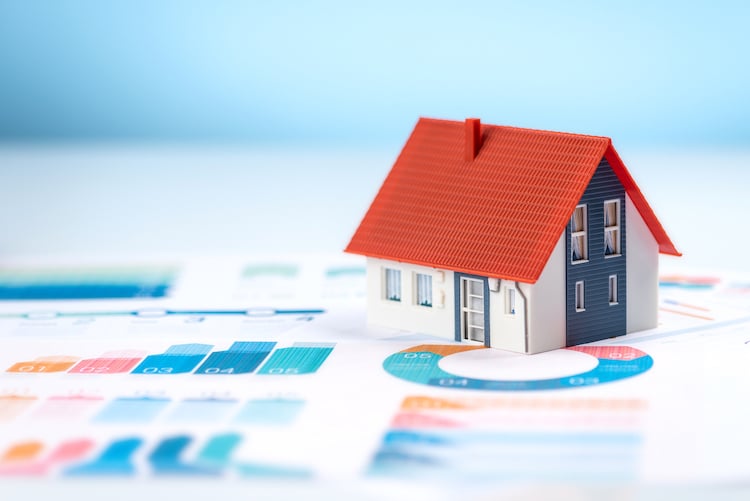The single-family rental (SFR) sector is performing well this year, and has yet to show any signs of slowing down. As rents rise and home values soar, a growing number of people are thinking about investing in real estate.
In this article, we’ll take an in-depth look at the main reasons why people invest in real estate, explain how the real estate market cycle works, and discuss the most common ways to begin investing in real estate today.
Key takeaways
- The main reasons for investing in real estate include cash flow, tax deductions, appreciation and depreciation, and a hedge against inflation.
- Since 1818, the real estate market has moved through 18-year cycles of recession, recovery, expansion, and hypersupply.
- Purchasing a single-family rental property, buying shares of a REIT, or putting money into a real estate crowdfund are three popular ways to invest in real estate.
- Real estate investors use a variety of metrics when analyzing the potential returns of a rental property, including cash flow, cash on cash return, and cap rate.
8 reasons why people invest in real estate
There are a variety of potential benefits to investing in a good single-family rental home or small multifamily property.
From rental income, to property value appreciation over the long-term, and numerous tax benefits, here are 8 reasons why people invest in real estate:
1. Cash flow
Money left over at the end of each month after the tenant rent has been collected and the bills have been paid. Also known as net income, the potential for cash flow is often the #1 reason for investing in real estate.
2. Tax deductions
The expenses of owning and operating a rental property can all be deducted from gross rental income to reduce the amount of income subject to tax. Typical expenses include property management and leasing fees, maintenance and repairs, taxes and insurance, and interest expense.
3. Depreciation
A non-cash expense used to reduce pre-tax income. The IRS allows residential real estate to depreciate a residential property over 27.5 years. For example, if a home is worth $110,000 (excluding the value of the lot), an investor may deduct $4,000 per year from the property’s net income.
4. Appreciation
Real estate historically increases in value when held as a long-term investment. Since 2000, the median sales price of houses sold in the US has more than doubled, from $163,200 in Q2 2000 to $374,900 in Q2 2021, according to the Federal Reserve.
5. Inflation hedge
In general, as the economy expands the demand for housing drives rent prices and home values up. When rents and net operating income increases, property values also tend to rise. Inflation is passed through to the tenant in the form of rent increases, and incorporated into the property value in the form of appreciation.
According to the BLS, the consumer price index (CPI) has increased by 5.4% over the past 12 months (July 2021), while rent growth has accelerated to 12.7% year-over-year (Arbor Q2 2021 SFR Investment Trends Report) and home values have grown by 16.7% (Zillow through July 31, 2021).
6. Build long-term wealth
A good way to visualize how investing in real estate can build long-term wealth is by drawing a 2-inch line on a piece of paper.
The left side of the line represents the current mortgage balance, the right side of the line represents the current value of the home, and the length of the line between the mortgage balance and current value shows the equity in the home.
As the mortgage is paid down each month, the left side of the line gets longer because equity increases as the loan balance is reduced. As home values increase, the right side of the line also gets longer, increasing accrued equity even more.
Over a period of time, the 2-inch line becomes longer and longer as mortgage payments reduce the loan amount while appreciation increases the home’s value. According to Zillow (July 2021), in less than 10 years, the typical value of a middle price tier single-family home in the US has increased by about 85%.
7. Use of leverage
Financing is usually widely available for investing in single-family rental homes and small multifamily buildings. For example, a conservative 25% down payment can be used by an investor to get 100% of a rental property.
Instead of paying all cash for one home, an investor may be able to acquire two, three, or four homes with the same amount of capital to increase the potential overall return on investment.
8. Diversify investments
Real estate investing may be a good way to diversify an investment portfolio beyond traditional assets like stocks, bonds, and even precious metals. Residential investment real estate typically has a low correlation with the overall stock market. As a recent report from Nareit explains, real estate is more countercyclical, tending to do well when stock market returns are disappointing.

How real estate market cycles work
While there are plenty of potential benefits to real estate investing, there are also challenges to be aware of as well.
Although it may be difficult to believe based on the performance of the market over the past several years, the real estate market historically moves through phases where home values decrease as well as increase.
In an article titled “How to Use Real Estate Trends to Predict the Next Housing Bubble” from the Harvard Extension School, researchers revealed that as far back as 1818, the real estate market has generally moved through 18-year cycles with four specific phases:
- Phase I: Recovery from a recession with no new construction in the market, declining vacancy, and occupancy below the long-term average.
- Phase II: Expansion as new construction begins, vacancy continues to decline, and occupancy grows above the long-term average.
- Phase III: Hypersupply caused by significant amounts of new construction, increasing vacancy, and occupancy moving below the long-term average.
- Phase IV: Recession characterized by increasing vacancy as an oversupply of building hits the market, pushing occupancy well below the long-term average.
During the economic downturn during the Great Recession of 2007 to 2009, the median sales prices of houses sold in the US declined by nearly 20%, according to the Federal Reserve Bank of St. Louis (Q1 2007 to Q1 2009).
The Federal Reserve Bank of Chicago estimated there were 3.8 million foreclosures between 2007 and 2010, partially as a result of declining home prices, turning many people into renters instead of owners.
While it may be possible to generate a profit through all stages of the real estate cycle by using different investment strategies, experienced investors are aware that real estate prices can go down as well as up.
Other potential drawbacks to consider before investing in real estate include:
- Real estate is an illiquid asset because it can not be quickly turned into cash the way the stocks and bonds can.
- Buying and selling real estate requires time, effort, and market knowledge.
- Dealing with tenants and maintenance issues can be time consuming.
- Taking out a mortgage to purchase a rental property requires a large down payment, and an investor runs the risk of a home depreciating if property prices enter a cyclical decline.
- Increased liability risk of being sued by tenants, guests, or vendors for accidents that occur on the property.
Ways to begin investing in real estate
There are literally dozens of ways to begin investing in real estate, some without actually owning a property directly.
For example, shares of publicly-traded real estate investment trusts (REITs) can be bought and sold on major trading platforms like Robinhood and Interactive Brokers, while the real estate crowdfunding site Fundrise requires a minimum investment of just $10.
Three of the most common ways to invest in real estate are:
Directly investing in a rental property
Roofstock is used by buyers and sellers around the world to invest in real estate in the US. In fact, in less than six years, more than $3 billion in single-family rental (SFR) transactions have been completed on the RoofstockMarketplace.
In addition to buying a rental property through Roofstock, investors may purchase a portfolio of multiple rental homes or a newly built home from Lennar.
Real estate investment trust (REIT)
REITs are companies that own, operate, or finance income-producing residential and commercial real estate. Shares of publicly-traded REITs can be bought and sold on major stock trading platforms.
Some of the largest public residential REITs include Equity Residential, AvalonBay Communities, and Invitation Homes. According to a recent report from Nareit, the 20 residential REITs reviewed had a year-to-date return of 41.46% and an average dividend yield of 2.38% (as of July 31, 2021).
Real estate crowdfunding
Real estate crowdfunding companies raise capital from a large pool of investors to purchase, develop, and operate large projects such as shopping centers, apartment buildings, and new home developments.
Investing in a real estate crowdfund can be a good way to participate in deals that are beyond the individual reach of many investors. However, somereal estate crowdfunding opportunities are reserved for accredited investors.
NerdWallet ranks Fundrise, CrowdStreet, DiversyFund, EquityMultiple, and Yieldstreet among the best real estate crowdfunding platforms.
Keep in mind that there’s no rule that says that someone can only invest in real estate one single way. Some people use a variety of different strategies to invest in property in an effort to minimize risk and maximize potential reward.
Key real estate investing metrics
Not every rental property offers the same potential return on investment. To help identify the best rental property opportunities, investors use a variety of metrics to measure property value and forecast potential returns:
Cash flow
Cash flow (also known as pre-tax net income) is the money left over at the end of each month after the rent has been collected and the bills have been paid. Note that cash flow isn’t always the same from one month to the next, because expenses in one month may be higher than normal or it may take longer than expected to fill a vacant home.
Cash on cash return
Cash on cash return is a metric that measures the amount of annual pre-tax cash flow to the amount of cash invested. For example, if a single-family home is purchased using a down payment of $25,000 and the annual cash flow is $3,000, the cash on cash return is 12% ($3,000 annual cash flow / $25,000 cash invested).
Net operating income
Also known as NOI, net operating income is calculated by subtracting normal operating expenses from the total income received. NOI does not include mortgage principal and interest (P&I) payments, capital expenses, or depreciation expense.
Capitalization rate
Capitalization rate (commonly referred to as cap rate) is a metric that shows the annual rate of return a rental home generates. To calculate a property’s cap rate, divide the NOI by the market value or purchase price of a home. For example, if a home has a market value of $100,000 and the annual NOI is $6,000, the cap rate is 6% ($6,000 NOI / $100,000 Home Value).
Tips for starting a real estate business
For people who decide that directly investing in real estate is the best choice, there are nine basic steps to follow to start a real estate business:
- Clarify an investment strategy by deciding whether to be an active or passive investor, such as finding and flipping homes versus buying-and-holding rental property for the long term.
- Create a business plan that outlines the specific steps for success, including both short-term and long-term objectives.
- Calculate start-up costs for setting up a business entity, applying for a business license, and selecting an asset management system like Stessa to track performance at both the property and portfolio level.
- Choose a business structure such as a sole proprietorship, partnership, S Corporation, or limited liability company (LLC).
- Create a pro forma for real estate that includes items like projected gross income, operating expenses, and capital expenditures.
- Research potential investments on sites such as the Roofstock Marketplace to learn more about rental properties for sale in some of the hottest markets in the US.
Wrapping Up
Real estate investing offers a variety of potential benefits, along with some drawbacks to consider as well. Many people invest in real estate for the cash flow, appreciation, and tax benefits. However, real estate is also an illiquid investment and the market historically moves through cycles where property values can decrease as well as increase. That’s why many investors who decide to purchase real estate buy-and-hold over the long term.









